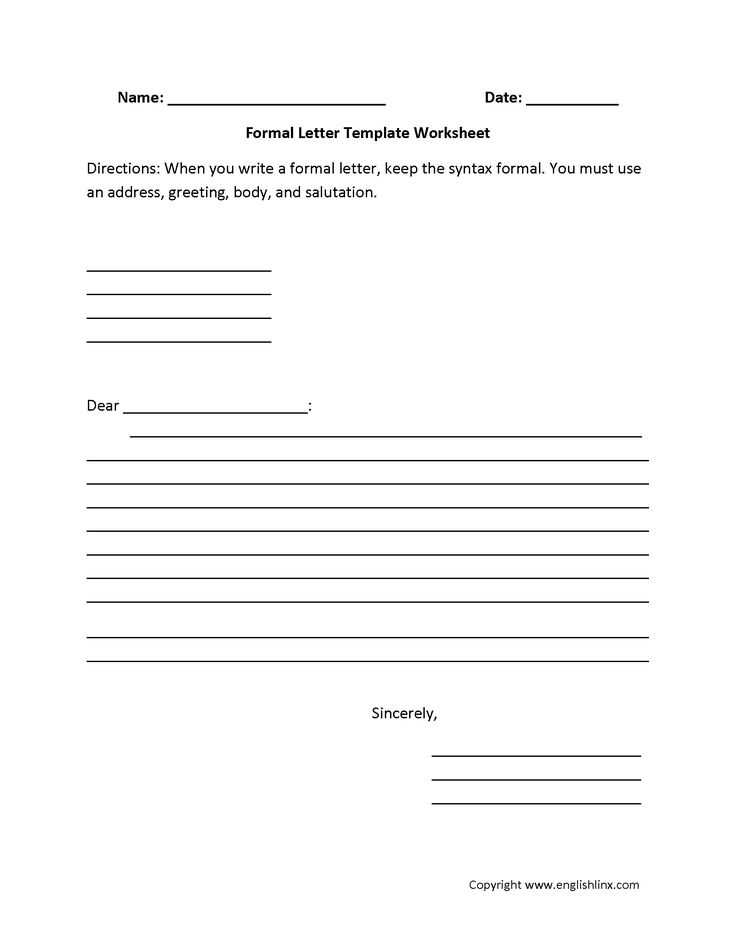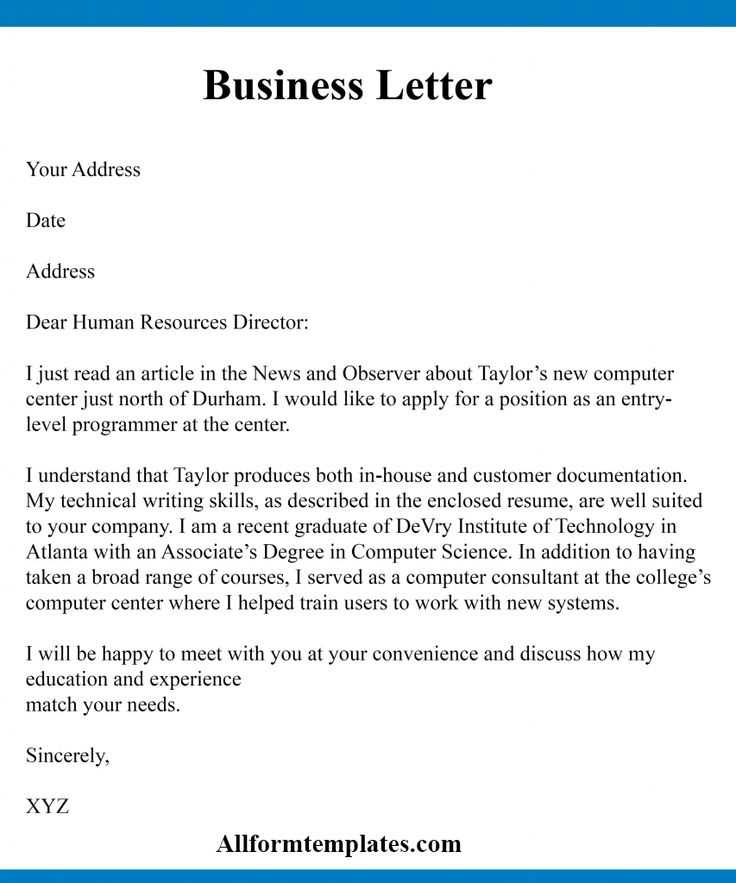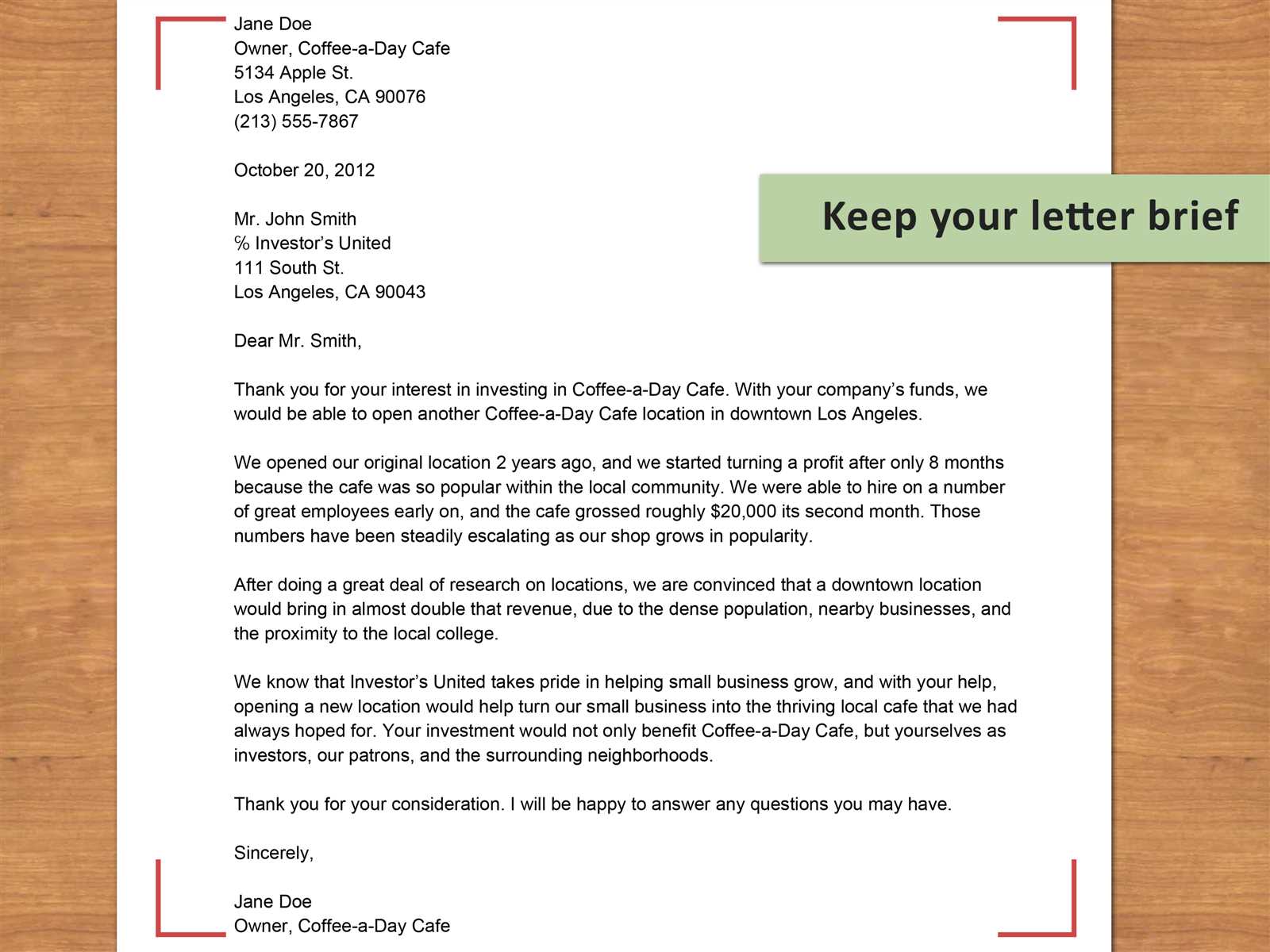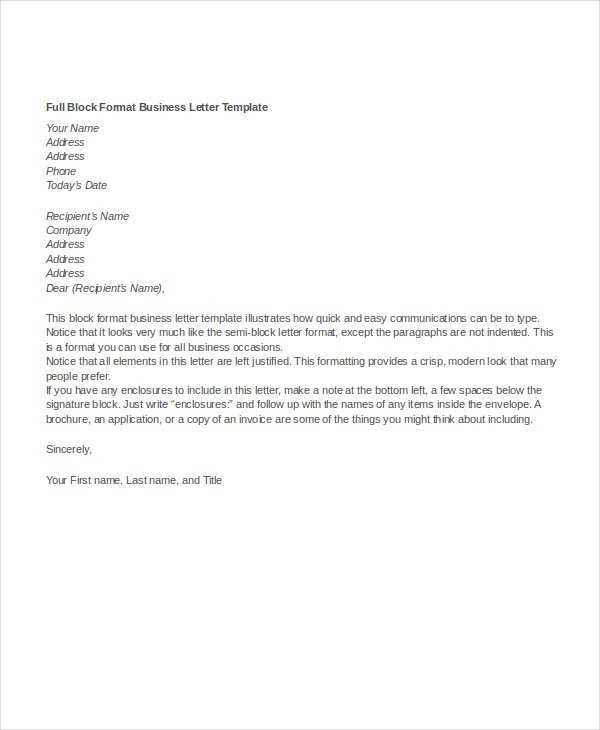Letter to a business template

When crafting a letter to a business, it’s crucial to maintain clarity and directness. Start by clearly stating the purpose of the letter in the opening sentence. Whether you’re requesting information, addressing a concern, or proposing a collaboration, be specific about what you want and why it matters.
Keep the tone respectful yet professional. Acknowledge the recipient’s position or role in the company, and ensure your language conveys professionalism while also being approachable. Avoid jargon that might confuse the reader and stick to simple, straightforward language.
Provide all necessary details without overwhelming the reader. Include relevant facts, such as dates, reference numbers, or project specifics, depending on the context. Organize your letter into clear sections, with each paragraph covering a distinct point. This will help the reader follow your message easily.
Close your letter with a call to action or request for follow-up, indicating what steps you’d like the recipient to take next. Be polite and express your appreciation for their time and consideration.
Letter to a Business Template

Keep your business communication clear and to the point. Focus on the purpose of the letter from the start. Address the recipient formally but maintain a friendly tone to build rapport. Stay organized in your approach–avoid overwhelming your reader with unnecessary details. Prioritize your key message, ensuring it’s easy to follow and actionable.
Key Components of a Business Letter
Start with the date and the recipient’s contact information, followed by a clear subject line if necessary. Use a formal greeting, and make your opening sentence direct and purpose-driven. If the letter involves a request or action, state it clearly. Conclude with a polite call to action or an expectation of follow-up. Always end with a professional closing, such as “Sincerely” or “Best regards.”
Best Practices
Keep the language concise, avoiding jargon or overly complex phrasing. Break the content into short paragraphs to make the text easy to read. If you need to include multiple points, use bullet points or numbered lists. Double-check for grammar and spelling errors before sending. This will ensure your letter maintains professionalism and readability.
Choosing the Right Salutation for Business Communication
Start with a formal greeting like “Dear [Name]” if you know the recipient’s name. It shows respect and professionalism. If you’re unsure about the name or the relationship, use a neutral salutation such as “To Whom It May Concern” or “Dear Sir/Madam.” These are safe choices in formal settings but should be used sparingly to avoid sounding impersonal.
For emails or letters to colleagues or familiar clients, opt for “Hello [Name]” or “Hi [Name]” to maintain a friendly tone without losing professionalism. When addressing a group, “Dear Team” or “Hello Everyone” is appropriate. These salutations convey inclusivity and respect for all recipients.
In case of a highly formal situation, such as communicating with senior executives or in legal contexts, using titles like “Dr.” or “Mr./Ms.” followed by the last name is a safe choice. Avoid overly casual greetings such as “Hey” or “Hi there” unless you have an established informal rapport.
When unsure, always lean towards formality. Adjust the salutation based on the level of familiarity and the tone of the overall communication. A well-chosen salutation sets the right tone for the rest of your message.
Crafting a Clear and Concise Subject Line

Focus on clarity and specificity. A subject line should directly reflect the core message of your email, making it easy for the reader to understand its purpose at a glance. For example, instead of using vague terms like “Update,” state exactly what the update is about, such as “Q1 Sales Report Update.” This will save the recipient time and set clear expectations.
Keep it brief but informative. Aim for a subject line that’s no longer than 8-10 words. If it’s too long, recipients may lose interest or fail to see the main point. Prioritize the most relevant details, such as the action required or the topic of discussion.
Avoid unnecessary words or filler. Eliminate any adjectives that don’t contribute to the message’s meaning. A direct approach makes your subject line more impactful. For example, instead of “Important Update Regarding the Upcoming Meeting,” use “Meeting Agenda for February 2nd.”
Use keywords that make the purpose of the email instantly recognizable. Incorporate action verbs or time-sensitive terms if appropriate. This helps recipients quickly assess the urgency of your email. For instance, “Action Required: Approve Budget by Friday” gives the recipient a clear sense of what’s needed and when.
Building a Professional Tone Throughout the Letter
Maintain clear and concise language. Avoid overly casual or conversational expressions that may undermine the seriousness of the communication. Use direct, respectful language that conveys your message with confidence.
Structure your sentences logically, keeping the tone formal yet approachable. Eliminate any unnecessary words that don’t contribute to the purpose of your letter. Each paragraph should address a specific point, making it easier for the reader to follow and understand your message.
Always use polite, neutral phrases. For example, replace “I hope you will consider” with “I request your consideration.” This shifts the tone to one of professionalism and respect.
Pay attention to your word choice. Instead of using ambiguous or overly elaborate terms, select words that are straightforward and precise. This will reflect your respect for the reader’s time and ensure clarity.
Finally, make sure the closing of the letter mirrors the tone established throughout. Use phrases like “Kind regards” or “Sincerely,” which convey professionalism without being overly formal.
How to Structure Your Message for Clarity and Impact

Keep your message concise. Aim to communicate your main points clearly without unnecessary details. Start with a strong, direct statement that highlights the purpose of your letter. This lets the recipient quickly grasp what you’re addressing.
Organize your content logically. Break your message into distinct sections, each covering a single idea or point. This makes it easier for the reader to follow along and grasp your argument or request.
- Introduction: Clearly state the purpose or reason for writing.
- Body: Present your main points in a logical order. Use bullet points or numbered lists to highlight important aspects.
- Conclusion: Recap the key points and specify any action needed from the recipient.
Use headings or subheadings to separate sections if your message covers several topics. This enhances readability and allows the reader to easily find the information they need.
Be specific and avoid generalizations. Provide concrete examples, data, or facts that support your message. This adds weight to your words and makes your argument more convincing.
Keep your tone professional but approachable. Use a clear, direct voice and avoid jargon or overly complex language. The goal is for the recipient to easily understand your message without confusion.
Finally, close with a call to action. Let the reader know exactly what you expect from them or what next steps are required.
Incorporating Key Information Without Overloading the Reader
Focus on delivering only the most relevant details in a concise, structured manner. Break information into digestible sections using bullet points or short paragraphs to maintain clarity. Avoid cluttering the letter with unnecessary data that may divert attention from the core message.
Present facts in a logical order, starting with the most urgent or important points. This allows readers to quickly grasp the essential content without having to sift through irrelevant details. For example, if you’re discussing a proposal, place the benefits or key outcomes at the beginning, followed by the necessary supporting details.
Use tables to present data clearly and minimize the risk of overwhelming the reader. A table allows you to display complex information in an easy-to-follow format, helping readers process it without feeling inundated. Here’s an example:
| Aspect | Details |
|---|---|
| Benefit | Improves communication and efficiency |
| Target Audience | Managers and team leads |
| Expected Outcome | Enhanced team performance |
Keep the tone direct and easy to follow, steering clear of jargon or overly technical language. This ensures that even if the reader isn’t familiar with certain terms, they can still grasp the key points effortlessly.
Finally, leave room for follow-up or clarification. This allows the reader to reach out for more details without feeling overwhelmed by too much information in one go.
Polishing the Closing to Leave a Positive Impression
Conclude your letter by expressing gratitude in a way that feels genuine and tailored to the recipient. Avoid generic phrases and focus on a specific aspect of your conversation or collaboration. This shows you appreciate the recipient’s time and effort.
End with Confidence
Avoid uncertainty in your closing. Phrases like “I hope this helps” or “Please let me know if you need anything” can make you appear unsure. Instead, express your confidence in the next steps. For example, “I look forward to hearing from you soon” or “I’m excited to collaborate further.” These statements inspire trust and leave a lasting positive impression.
Clear Call to Action
Close with a clear action step or expectation. Ensure the recipient understands what comes next. A simple line like “Feel free to reach out for any questions” or “I’ll follow up with you next week” creates clarity and encourages further communication. Make it easy for them to respond or act without confusion.
By refining your closing, you show professionalism, respect, and an eagerness to continue building the relationship. This final touch can be the difference between a forgotten message and one that stands out for all the right reasons.